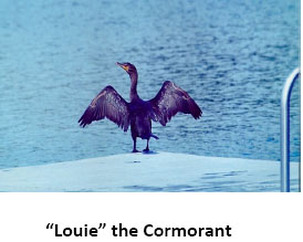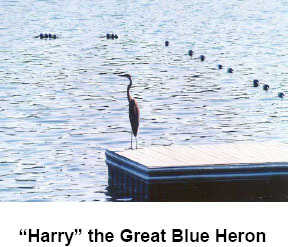Crystal Lake Inhabitants *** Article by Beth WilkinsonThe human residents of Newton share Crystal Lake with many other animals. Like most everywhere else in Newton, there are squirrels and chipmunks running through the grass and trees by the lake, but the lake also is home to animals found only in the few aquatic areas of the city.
“Louie” the Cormorant The most popular water bird at the lake this summer was a cormorant (probably a Double-Crested Cormorant), named Louie by the young swimmers who shared the dock with him. Louie often was seen on the dock with his wings outstretched to form an upside-down “W.” Because their feathers are not waterproof, cormorants must dry them in the sun after diving for food. It’s easy to distinguish Louie from the ducks because cormorants swim low in the water with only their necks and heads above water. Cormorants are social birds that usually live in colonies, so it is odd that Louie lives alone on the lake with only occasional visits from other cormorants--possibly from the colony at Bullough’s Pond. |
|
“Harry” the Great Blue Heron
There has been another beautiful lone bird on the lake this summer: a Great Blue Heron, named Harry by the young swimmers. Harry often is seen standing at the edge of the lake by a clump of birches on a peninsula near the Green Line tracks. Adult Great Blue Herons grow to a height between 3 and 4 feet, but because of their hollow bones, they weigh only five pounds. Harry, like all herons, wades in shallow water to search for the fish that he loves to eat. Muskrats Harry shares the bank of the lake near the birches with a sleek muskrat. The Crystal Lake muskrat is seen most often as a brown body streaking through the water. Muskrats are able to swim under water for twelve to seventeen minutes; they are able to do that because (like whales and seals) they are less sensitive than most mammals to the build-up of carbon dioxide in their bodies. They also are able to do something that many human swimmers might envy--to close off their ears to keep the water out. |
Belted Kingfisher
A family of Belted Kingfisher birds has been seen around the lake this summer. It is suspected that they live on the bank with Harry the Great Blue Heron and the muskrat, but no one has been able to discover their home. Kingfishers, a beautiful gray-blue with a white belly and a blue breast band, are unusual in the bird world because the female is more vividly colored than the male: she has an additional reddish brown band beneath her blue chest band.
Fish
There are plenty of fish for the birds--and people--to catch. Every spring, the State Division of Fisheries and Wildlife stocks the lake with 350 two-year-old trout that were raised in state hatcheries to help to keep balance in the aquatic environment and to support state residents who like to fish in Great Ponds like Crystal Lake. As the water warms up, the trout retreat to the cool water at the bottom of the lake. Other fish are Bluegills, which prefer to hide in the plants in the shallower and warmer water, and Pickerel, the largest fish in the lake, which also eat smaller fish. When you walk by the lake, you should thank the Bluegills because they help limit the insect population by eating a variety of insect larvae that float on the water; an adult Bluegill is a voracious eater that can consume up to six times its own weight in a single summer. Visitors have seen two large white Koi with orange spots in recent years. The best guess is that someone closing a backyard fishpond released them into the lake. Releasing non-native species like these Koi into lakes is illegal. Why? Because they will either eat the young native fish or out-compete them for the available food.
Turtles
Turtles come to sun themselves on a series of boards that have been placed at the edge of the swimming area. Painted Turtles are the most popular. In the past month, a snapping turtle was seen in the water with only its distinctive head exposed. Although snapping turtles usually swim away and avoid confrontation with people, they can be aggressive if approached, and their bites can be dangerous, so it is best to avoid interactions with them.
Children and adults spending time often report their discoveries to Carol Stapleton, the Manager of the bathhouse. She uses those discoveries to help the children learn to love and respect nature. The bulletin boards of the bathhouse are filled with photos of insects and birds, and the shelves in her office hold field guides that she shares with the budding naturalists.
How many of the creatures listed above have you seen? Have we missed one of your favorites? We’d love to hear your stories--and might even include one in a future newsletter.
A family of Belted Kingfisher birds has been seen around the lake this summer. It is suspected that they live on the bank with Harry the Great Blue Heron and the muskrat, but no one has been able to discover their home. Kingfishers, a beautiful gray-blue with a white belly and a blue breast band, are unusual in the bird world because the female is more vividly colored than the male: she has an additional reddish brown band beneath her blue chest band.
Fish
There are plenty of fish for the birds--and people--to catch. Every spring, the State Division of Fisheries and Wildlife stocks the lake with 350 two-year-old trout that were raised in state hatcheries to help to keep balance in the aquatic environment and to support state residents who like to fish in Great Ponds like Crystal Lake. As the water warms up, the trout retreat to the cool water at the bottom of the lake. Other fish are Bluegills, which prefer to hide in the plants in the shallower and warmer water, and Pickerel, the largest fish in the lake, which also eat smaller fish. When you walk by the lake, you should thank the Bluegills because they help limit the insect population by eating a variety of insect larvae that float on the water; an adult Bluegill is a voracious eater that can consume up to six times its own weight in a single summer. Visitors have seen two large white Koi with orange spots in recent years. The best guess is that someone closing a backyard fishpond released them into the lake. Releasing non-native species like these Koi into lakes is illegal. Why? Because they will either eat the young native fish or out-compete them for the available food.
Turtles
Turtles come to sun themselves on a series of boards that have been placed at the edge of the swimming area. Painted Turtles are the most popular. In the past month, a snapping turtle was seen in the water with only its distinctive head exposed. Although snapping turtles usually swim away and avoid confrontation with people, they can be aggressive if approached, and their bites can be dangerous, so it is best to avoid interactions with them.
Children and adults spending time often report their discoveries to Carol Stapleton, the Manager of the bathhouse. She uses those discoveries to help the children learn to love and respect nature. The bulletin boards of the bathhouse are filled with photos of insects and birds, and the shelves in her office hold field guides that she shares with the budding naturalists.
How many of the creatures listed above have you seen? Have we missed one of your favorites? We’d love to hear your stories--and might even include one in a future newsletter.


